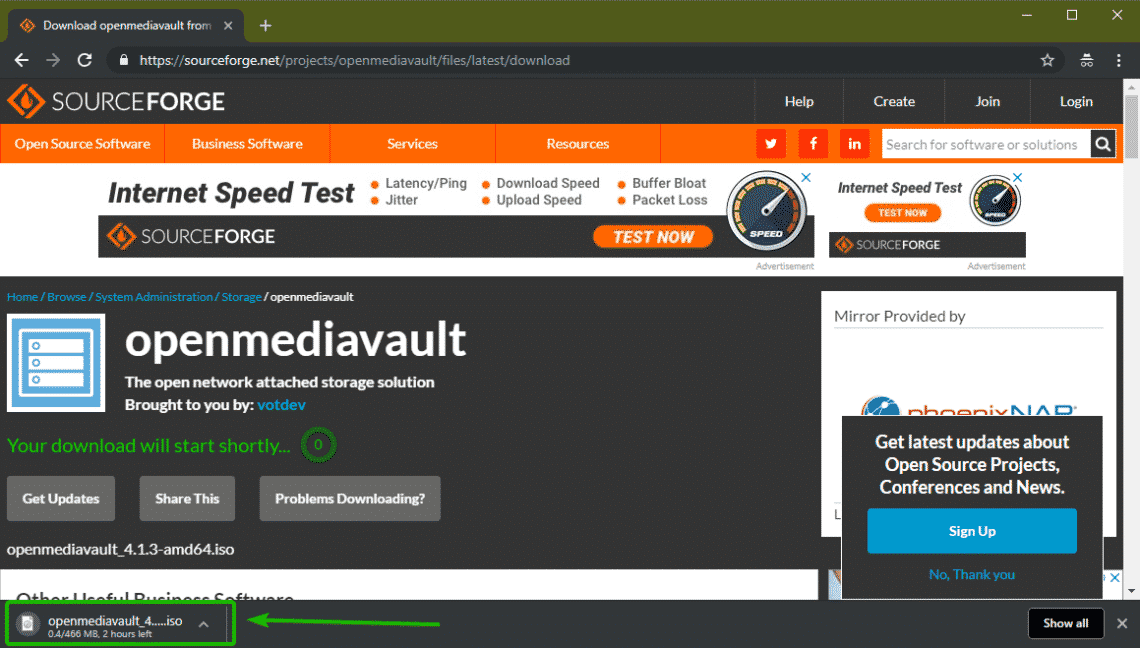openmediavault is the next generation network attached storage (NAS) solution based on Debian Linux. It contains services like SSH, (S)FTP, SMB/CIFS, DAAP media server, RSync, BitTorrent client and many more. Thanks to the modular design of the framework it can be enhanced via plugins.
openmediavault is primarily designed to be used in small offices or home offices, but is not limited to those scenarios. It is a simple and easy to use out-of-the-box solution that will allow everyone to install and administrate a Network Attached Storage without deeper knowledge.
- Running out-of-the-box
- Debian Linux OS
- Web based administration
- Easy system updates via Debian package management
- Volume management
- S.M.A.R.T.
- Link aggregation
- Wake On Lan
- IPv6 support
- Email notifications
- File sharing
- Extendible via plugins
- In the plugins section choose upload, and upload your.deb file. Install the openmediavault-omvextrasorg plugin which will allow you to have access to all the plugins you would ever need! (note that you may need to click “check” after installing to ensure the plugins are being picked up). You now have a PiNAS.
- Installation on USB omv can be installed on an USB flash drive to boot from it. Follow the:doc:`Install on Dedicated Drive installation/viaiso` and select your USB flash drive as target drive. Enable the openmediavault-flashmemory plugin. This lowers the amount of writes to the USB flash drive, making sure you can enjoy it for a long time.
OpenMediaVault is great NAS OS and I prefer it over FreeNAS or other BSD based NAS solutions. I guess that OMV being based on Debian is a major plus with me. But, there is a nasty side of OMV – they do not support using OS drive for data storage (as noted in OMV installation guide ) and if you install OMV on a 1TB drive you can say goodbye to.
Suche neue Herausforderung
In eigener Sache.
Ich suche beruflich eine neue Herausforderung. Wenn Sie eine interessante Vollzeit- && Remote Stelle im Bereich … offen haben und denken ich könnte Ihr Team verstärken, dann melden Sie sich doch unter volker.theile_at_openmediavault.org bei mir.
Sie können mich bei Xing und LinkedIn finden.
0 commentsOMV6 – First shared folder ACL impressions
 0 comments
0 commentsOpenmediavault Install Omv Extras
New update available
openmediavault 5.5.17
WARNING … This update might cause problems on systems that are using USB hardware based on JMicron controllers.
- Update locales.
- Issue #842: Fix bug in UDEV rules to workaround a JMicron bug. If your USB controller reports the vendor ‘JMICRON’, then you might be affected by this issue. After installing this package your mounted filesystem configuration might be broken. To fix that, you need to unmount and remount the filesystems that are connected via this USB controller. If the filesystem contains any shared folders, you can’t unmount it, because of that you need to delete all shared folders that are located on the filesystem to be unmounted. Make sure to choose the right menu to only delete the shared folder configuration WITHOUT the content. You can only delete shared folders they are not used by any service, so make sure this applies to these shared folders. After you’ve unmounted these filesystems in the UI, apply the changes, reboot the system and then mount the filesystems again. After that you can reconfigure your shared folders and services from scratch. Sorry for this inconvenience.
- Issue #846: Fix locking issue in SMB recycle bin cleanup and iptables scripts.
- Check if your hardware is supported on the system requirementspage.
- Download aninstallation image file for your system. openmediavault provides ISO installersfor x86 architecture and several preconfigured images for ARM devices.
- Disconnect all disk devices except the one for the system drive. This way youavoid an accidental install on a storage drive (which will be configuredafter installation anyway).

Choose your installation variant and follow the instructions.
- Dedicated drive - Advised method via ISO image. This runs OMV from its own drive.
- USB flash drive - This runs openmediavault from a USB flash drive.
- Debian Operating System - This runs openmediavault as a services on top of a Debian OS.
- Debian Operating System via deboostrap. Use this as a last resort in case the installer does not recognize a specific essential hardware component like hard disk (NVME) or a network card that needs a higher kernel (backport).
- SD card - This runs openmediavault from a SD card.
If you have a screen attached, KVM or IMPI console the login screen willdisplay the current IP address assigned for the web interface. Open your browserand type that IP address. The default web interface login credential isadmin:openmediavault, the root password is the one you setup duringinstallation.
Openmediavault 5 Usb Install
For ARM images the root password is the same as admin password.
Note
openmediavault will enable SSH access for the user root by default to beable to access a headless system in case of a broken installation orother maintenance situations. You can disable this behaviour in theServices|SSH page.
Openmediavault Usb Flash Install
To still get root access you need to create a non-privileged userand add them to the ssh and sudo groups. After that you canSSH into the system with this non-privileged user and run sudosu.
